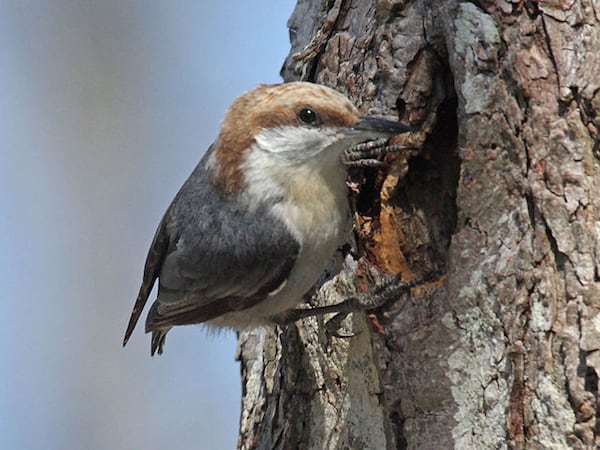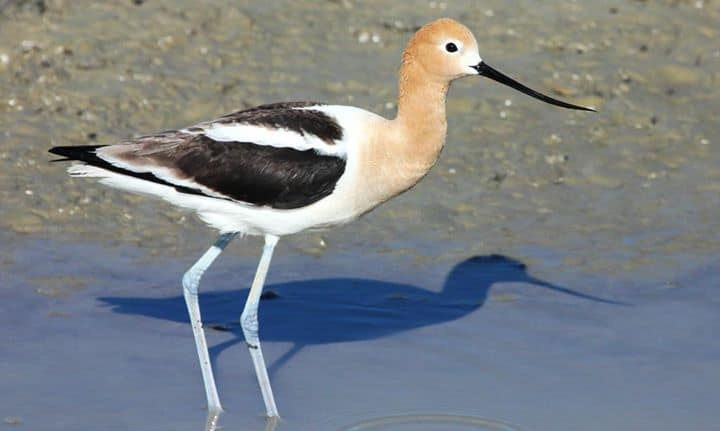Georgia is made up of many different types of areas within the state. This has profound effects on what birds you can expect to find and when, so it’s useful to try to split the state up into smaller units for this purpose. We will be using the concept of the “eco-region” here, though there are many smaller units that could also be used. Basically, the land areas of Georgia can fairly easily be split up into four such eco-regions.
The four main eco-regions in Georgia, based on physical features, are mountains, piedmont, coastal plain, and coast. An additional eco-region is the offshore waters of the Atlantic Ocean for pelagic species, birds found only away from the coast. Of course, many of the more common species are found statewide in every eco-region, but some are very restricted or found more commonly in one region over another so for the Georgia bird watcher it’s useful to try to understand these differences.
Mountains
The mountain eco-region is in the northern part of Georgia and may be most easily described by what it isn’t! It’s everything north of the piedmont, which will be described in the next section. It extends to the Tennessee and North Carolina borders to the north, to Alabama to the west, and to just a bit of South Carolina to the east as this region angles up toward the northeast.
The mountain region is actually three smaller regions or provinces lumped together for their proximity and in many cases their birdlife. In the far northeast section of the state are the only real mountains in Georgia, and this province is called the Blue Ridge province. It contains all of Georgia’s highest mountains, and has a distinctly northern flavor to both its birdlife and oftentimes its plantlife.
The extreme northwest corner of the state is the Cumberland Plateau, the next highest part of Georgia—not as high as the Blue Ridge and without the true mountain component or as much northern bird and plantlife. Sandwiched in between these two is the Ridge and Valley province, a series of ridges with low valleys in between, and even though it’s pretty far north in the state it shares much of its birdlife with the piedmont region.
The Blue Ridge province is the highest section of Georgia by far, with elevations ranging from 1,600 to 4,700 feet. It’s also the coolest part of the state, with January temperatures ranging from 30 to 50 degrees F, and July temperatures ranging from 65 to 90 degrees F. With all this elevation and cooler temperature you can find many interesting plant communities and bird species.
Many of the highest mountains are actually “balds,” so named because they have just bare rock or stunted growth at the summit. The highest of these, such as Brasstown Bald and Rabun Bald, are the only places in the state to look for northern species such as breeding common ravens, veeries, Canada warblers, and rose-breasted grosbeaks. The upper elevations of this entire province have other breeding species not found in other regions, such as ruffed grouse, chestnut-sided, black-throated blue, Blackburnian and worm-eating warblers, and dark-eyed juncos.
Unique sections such as Burrell’s Ford have rare habitats for Georgia like old growth white pine/hemlock, and species to look for there include breeding red-breasted nuthatches. Other typical plants for this province are large hardwoods such as various oaks, evergreens, and shrubs such as mountain laurel and rhododendron.
The next highest province is the Cumberland Plateau, which is a fairly small area in the extreme northwest corner of Georgia. Elevations range from 800 to 2,000 feet, and this area is part of a high plateau (as the name suggests) that extends into parts of Tennessee and Alabama.
Lookout Mountain is the largest feature, and some of the same habitats as the lower sections of the Blue Ridge are found here, along with many of the same bird species except the ones identified for the balds. Other species found here are also found on many of the ridges in the Ridge and Valley province, such as blue-headed vireo, black-throated green warbler, and scarlet tanager.
In between these two provinces lies the Ridge and Valley, where elevations range from 700 to 1,600 feet. Most of the lower elevations are the valleys between the ridges, which are very piedmont-like in their plantlife and birdlife. The ridges and their higher elevations remain somewhat different from the piedmont, though, with many of the same species listed for the Cumberland Plateau.
Piedmont
Just south of the mountain eco-region is the piedmont, which is much more homogenous throughout. “Piedmont” is Italian for “the foot of the mountain,” which is a good description of the northern edge of the region. The southern edge is the “fall line,” a line roughly running from Columbus to Macon to Augusta across the center of the state. This line corresponds to a break from the relatively higher elevations of the piedmont to the lower elevations of the coastal plain.
Many rivers have waterfalls at this break. These waterfalls are where the term fall line comes from, even though many of those rivers are now dammed. These waterfalls provided a source of power to early settlers as well as an impediment to proceeding farther upriver, and this is why many of Georgia’s cities are situated right at the fall line. The western border for Georgia is the Alabama state line and the eastern border is the South Carolina state line.
The piedmont ranges in elevation from 500 to about 1,500 feet, with a few slightly higher sites such as Kennesaw Mountain at 1,808 feet. Temperatures, like elevation, are intermediate between the mountain and coastal plain regions. January temperatures average from 32 to 55 degrees F, and in July the average is 70 to 90 degrees F.
The peidmont region’s topography is more uniform than that of the mountains, with rolling terrain and a few isolated higher hills. Though many of these are called “mountains,” they are actually monadnocks, or isolated outcrops of hard rock (usually granite). Many of them, such as Kennesaw, are excellent migrant bird locations. The rivers in the piedmont are generally larger and flatter than those in the mountains.
The forested areas along rivers are excellent spots for not only migrants but many breeding species as well. Typical plants include many hardwoods as in the mountains, plus many evergreens in the form of pines. The types of trees or shrubs at a particular site may have strong implications for which birds you will find there.
Typical birds for the piedmont varied. Breeding species include whip-poor-will, hairy woodpecker, eastern phoebe, American robin, black-and-white warbler, and chipping, field, and song sparrows. Some of the winter species that are found easiest in the piedmont include horned grebe, brown creeper, winter wren, and golden-crowned kinglet.
Coastal Plain
The next Georgia eco-region to the south is the large coastal plain. It is bordered to the north by the fall line, and extends west to the Alabama border, south to the Florida border, and east to about I-95. For the purposes of this book the coastal plain can be considered as one entity stretching almost to the coast, to the approximate limits of tidal influence (about 30 miles).
The coastal plain is flat, mostly sand or clay and it was underwater for much of prehistory (the fall line was an ancient coastline). The elevation ranges from 70 to 500 feet, and the temperatures are just a couple of degrees warmer on average than the piedmont.
Within the coastal plain are many types of habitat, from river hardwoods (called riparian corridors when they follow a river), pine forests, swamps, agricultural fields and pastures, and ponds and lakes. Most of the large hardwoods occur along the rivers, and many of the best birding spots in this region are found there also.
You can’t go far in the coastal plain without finding pine trees, but the type of pine makes a big difference in what bird species you will see there. The red-cockaded woodpecker is a highly sought-after species. To find them, however, you need to look for their preferred pine species, which is longleaf in the south and loblolly toward the upper part of the coastal plain. Other typical species that favor pine, such as pine warbler and brown-headed nuthatch, are more widespread and less picky.
The river floodplain hardwood forests are good spots for migrant landbirds and host typical breeding species like Acadian flycatcher, northern parula, and Louisiana waterthrush. The cypress-tupelo swamp habitat is home to many waterbird species and landbirds such as the prothonotary warbler.
Waterbirds found in swamps and all non-flowing water habitats in the coastal plain include anhinga, great egret, and common moorhen. Fish crows are widespread in this region and have recently been moving into the piedmont as well. Cattle egrets nest in water habitats but are usually seen foraging in grassy fields and pastures or along grassy road corridors.
Coast
The last main eco-region in Georgia is the coast—everything between the coastal plain and the Atlantic Ocean. This strip of land is roughly 30 miles wide and includes all of Georgia’s barrier islands and mainland beaches. This region is flat, with a high point of about 70 feet, and has the same temperatures as the coastal plain. It often feels cooler due to the sea breeze, quite welcome on hot summer days.
In addition to the beaches, other important habitat types in this region include coastal scrub, salt marsh, and the tidally-influenced rivers. A very large percentage of this region is made up of salt marsh, much of which is inaccessible. Some species are common throughout this region, such as fish crow and boat-tailed grackle. Others are more discriminating, and are found only in one type of habitat.
For example, in the salt marsh typical species include clapper rail, marsh wren, and seaside sparrow. They are rarely found outside this habitat but can be fairly common within it. Beaches are well known as bird hotspots, and are great places to look for shorebirds, gulls, and terns. Year-round beach birds for Georgia include American oystercatcher, laughing gull, royal tern, and black skimmer.
Other common species are only here in one season. Winter species include most other shorebirds such as black-bellied plover, western sandpiper, and dunlin, higher numbers of gulls including herring and ring-billed, and Forster’s tern. Other species such as Wilson’s plover and Sandwich and least terns are found mostly during summer. In winter ducks such as bufflehead, red-breasted merganser, and black scoter are common here, and in summer it is home to the gorgeous painted bunting.
One last eco-region to discuss is the “offshore” region off the coast away from land extending out to the Gulf Stream almost 70 miles. Many birds found on the coast can be found out here, such as some of the gulls and terns, but there are also other species that never come to land at all in Georgia. These sea-going or “pelagic” species include summer species like Audubon’s shearwater and sooty and bridled terns, or rare winter species like the manx shearwater and razorbill. One winter species that inhabits this region is the northern gannet, They can often be seen from shore, unlike the other species listed here that can only be observed from a boat.




